OMSSA's 75th Anniversary

This year marks the 75th Anniversary of the Ontario Municipal Social Services Association. We are very pleased to be able to celebrate this incredible milestone with our Members and partners across Ontario. Below, you will see a history of human services in Ontario, the Association, and the key events and moments from the past 75 years.

OMSSA would like to sincerely thank John Stapleton for his contribution and content to assist with this celebratory review of the history of OMSSA and of human services in Ontario.
Please note: Certain information contains historical language and content that may be considered offensive or potentially harmful, such as language used to refer to racial, ethnic and cultural groups. The items in the collections, their content and descriptions reflect the period in which they were created and does not reflect the views of present-day OMSSA.
In 1950, forty people attended the first annual conference of the Ontario Welfare Officers Association (OWOA), the forerunner of the Ontario Municipal Social Services Association.
Pre-OMSSA (Post-War Construction: 1945-1950)
Following WWII, there was widespread fear that the economy would revert into Depression. Canada began to experiment with the view of the state as supporting markets and the economy through government programs and infrastructure. Nutrition, medicines and vaccines were promising paths out of poverty for all.
There were two broad elements being considered:
- The first was the Ontario Government’s decision in 1946 to revamp residential care for the elderly impinging greatly on municipal (and charitable) houses of refuge.
- The second was the very real tug of war between who should run social services
- a cadre of centrally administered professional social workers free from the interference of all governments; or
- the incumbent municipal structure that had increased its hold on service delivery during the war
With the federal government out of the game, the debate over centralization and professionalization took on a new life.
During the summer of 1947 these conflicting visions of welfare reform clashed head-on at the Ontario Conference of Social Welfare, a major gathering of provincial and federal politicians, social workers and municipal representatives of the Community Welfare Council of Ontario to debate the future of social assistance in the province
Enticed by 50% cost sharing, Toronto, Hamilton and Windsor formed Welfare Units in anticipation of the new legislation which was to have come out of the 1947 conference.
But the three new self-proclaimed welfare unit administrations did not necessarily accept the deep divisions between:
- left and right,
- academics vs. politicians, or
- certified professionals vs. administrators.
Many administrators thought the administration of welfare needed to be separated from partisan politics at all levels and required at least some professional social workers working alongside them.
They saw the great postwar debate as opening needless fault lines that were counterproductive to moving forward.
To these ends, a group of administrators, some who had attended the 1947 conference, began talking about forming a professional association and got down to business in 1949. They were encouraged by provincial welfare director James S. Band
OMSSA Past Presidents:
- R.J. Smith (1951-52)
- H.P. Goodfellow (1952-53)
- A.H. Frame (1953-54)
- H.E. Pense (1954-55)
- A.C. Huggins (1955-56)
- Jos. Vernon (1956-58)
- K.R. Ruddick (1958-59)
- George Whitman (1959-60)
Key Facts and Info About the 1950s
- Population of Canada in 1950: 13,712,000
- Population of Ontario in 1950: 3,500,000
- Prime Minister in 1950: Louis St. Laurent
- Premier in 1950: Leslie Frost
Key Events:
- Canada joins a United Nations force to fight in Korean War.
- Elizabeth II becomes Queen of Canada upon the death of her father George VI.
- Metropolitan Toronto comes into being to coordinate services among the various municipalities around Toronto.
- The Yonge St. subway, the first subway system in Canada, opens in Toronto.
- Hurricane Hazel hits Toronto killing 81.
- The first Canadian peacekeepers arrive in Egypt after the Suez Crisis.
- The first prototype Avro Arrow is presented to the media, has its first flight, and is terminated.
- The St. Lawrence Seaway opens.
1950’s
OMSSA was created to:
- represent municipal interests,
- share best practices, and
- advocate for improvements in the delivery of social services in partnership with the provincial government.
OMSSA focused on areas like welfare administration, public health, and housing, reflecting the social challenges of post-war Ontario.
Key Milestones and Accomplishments During the 1950s
- Formation of the Ontario Welfare Officers Association (forerunner to OMSSA).
- Divorced mothers added to Mother's Allowance for the first time.
- Blind persons and disabled persons allowances implemented.
- Vocational Rehabilitation (VRDP) introduced.
- The Goodfellow Commission on Ontario Indians led to inclusion of Indian delivery of social services on reserve as part of the General Welfare Assistance Act (GWA) in 1958.
- First Indian Social Services Act passed to provide parallel municipal services (child care, homemakers, child welfare, social assistance).
- Unwed mothers added to Mother's Allowance.
- First postwar recession: Ontario moves cost sharing with municipalities from 50/50 to 60/40.
- January 1, 1958 proclamation of GWA Act and repeal of the Unemployment Relief Act:
- Consolidated County and First Nation delivery allowed for first time.
- Employables allowed as category for the first time since 1941.
- Cost sharing moves to 50 (Fed) / 30 (Ont) / 20 (Municipal) where it stayed until 1992.
- Major increases in Old Age Pensions reduced municipal role in topping up aged benefits.
The Creation of Regent Park
“Regent Park was envisioned as a way to ease the post-Second World War housing crisis in the city, provide affordable places to live, and replace one of Toronto’s poorest slums. While experiments in social housing in Toronto dated back to the Toronto Housing Company’s Riverdale Courts (today’s Bain Co-Op) and Spruce Courts complexes in the 1910s, little more was accomplished until a committee headed by Lieutenant-Governor Herbert Bruce convened in 1934 to study housing conditions.”
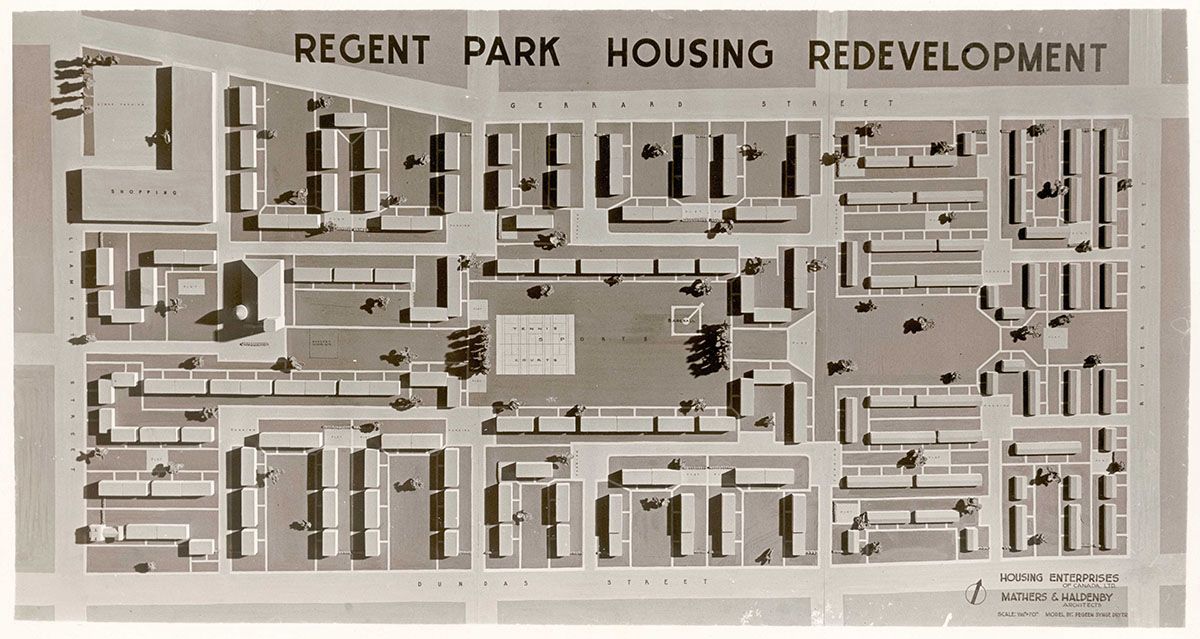
Plan for Regent Park as proposed by Housing Enterprise of Canada, Ltd., 1946. (City of Toronto Archives, Fonds 2, Series 60, Item 644)
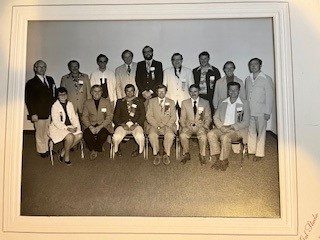



OMSSA Past Presidents:
- C.V. Smith (1960-62)
- A. Southern (1962-63)
- Ray Tomlinson (1963-64)
- Herb Ceseborough (1964-65)
- W.H. Hilts (1965-66)
- Simone Patterson (1966-67)
- W.J. Gigg (1967-68)
- K.K. Stokes (1968-69)
- T.R. Graham Reid (1969-70)
Key Facts and Info About the 1960s
- Population of Canada in 1960: 17,870,000
- Population of Ontario in 1960: 5,862,085
- Prime Minister in 1960: John Diefenbaker
- Premier in 1960: Leslie Frost
Key Events:
- Status Indians are given the right to vote.
- The Canadian Bill of Rights is given royal assent.
- First medicare plan is launched in Saskatchewan to great protest by doctors.
- Trans-Canada Highway opens.
- The Royal Commission on Bilingualism and Biculturalism is announced.
- Canada adopts the maple leaf for the national flag.
- The Canada Pension Plan and the Quebec Pension Plan both begin operation.
- Expo 67 opens in Montreal.
- Canada celebrates its centennial.
- Parliament decriminalizes consensual homosexual sex, with some exceptions.
1960’s
The decade saw the introduction of major provincial programs, like social assistance (General Welfare Assistance Act and Family Benefits Act and Guaranteed Annual Income System) and public housing initiatives. Programs flourish following the control of diseases including smallpox, polio and Tuberculosis, diphtheria, whooping cough. Concerted deinstitutionalization begins.
Increased collaboration between municipalities and the province. OMSSA played a key role in ensuring municipal perspectives were represented in these programs.
Key Milestones and Accomplishments During the 1960s
- Day Nurseries Act passes
- Establishes an "institution, agency or place...which for compensation or otherwise receives for temporary custody on a daily or hourly basis with or without stated educational purpose, during part or all of the day, apart from the parents, more than three children under seven years of age and not attending the first grade of school and not of common parentage, but does not include a nursery school or kindergarten..."
- Elderly Persons’ Centres Act passes
- Establishes long-term care centres to "...provide social, recreational or other services for elderly persons..."
- Indian Welfare Agreement (IWA) created
- The federal government would cover social services costs in accord with the federal Constitutional trust responsibility
- The province and federal government would cost share in the remaining (ordinary costs) on a 50-50 basis.
- Child Welfare Act Passes
- "A children's aid society may be established having among its objects the protection of children from neglect, the care and control of neglected children, assistance to unmarried parents, the placement of children in adoption, the supervision of children placed in adoption until an order of adoption is made...
- Homemakers and Nurses Services Act passes
- "The services of a homemaker may be...
- (a) for households in which there is a child who might otherwise be cared for in other than his own home during the temporary absence, illness or convalescence of his mother or other person in whose charge he is, where an adult is available to furnish any care that the child may require: when the homemaker is not on duty; or
- (b) for a person who is elderly, handicapped, ill or convalescent and who requires such services on a parttime or visitation basis in order that he may remain in his own home, where an adult is available to furnish any care that he may require when the homemaker is not on duty.
- The services of a nurse may be furnished under this Act on a visitation basis, in the home of a person who is elderly, handicapped, ill or convalescent, where a physician certifies that such services arc necessary to enable the person to remain in his own home or to make possible his return to his home from a hospital or other institution."
- "The services of a homemaker may be...
- Canada Assistance Plan (CAP) – 50% cost sharing
- Department of Public Welfare renamed: Department of Social and Family Services to reflect responsibilities under Canada Assistance Plan (CAP).
- Disability legislation consolidated under Family Benefits Legislation (Rates extended to those deemed "Possibly Unemployable" and 60+)
- Major overhauls to Old Age Security (OAS), Canada Pension Plan (CPP), Guaranteed Income Suppliement (GIS), and Canada Assistance Plan (CAP)
The Creation of the Ontario Housing Corporation
“…changes to the National Housing Act and the creation of the Ontario Housing Corporation in the 1960s created financial conditions that allowed for a tenfold increase in the province’s production of social housing — spurring the emergence of a co-operative-housing movement.”
The rise and fall of co-op housing in Ontario by Kunal Chaudhary
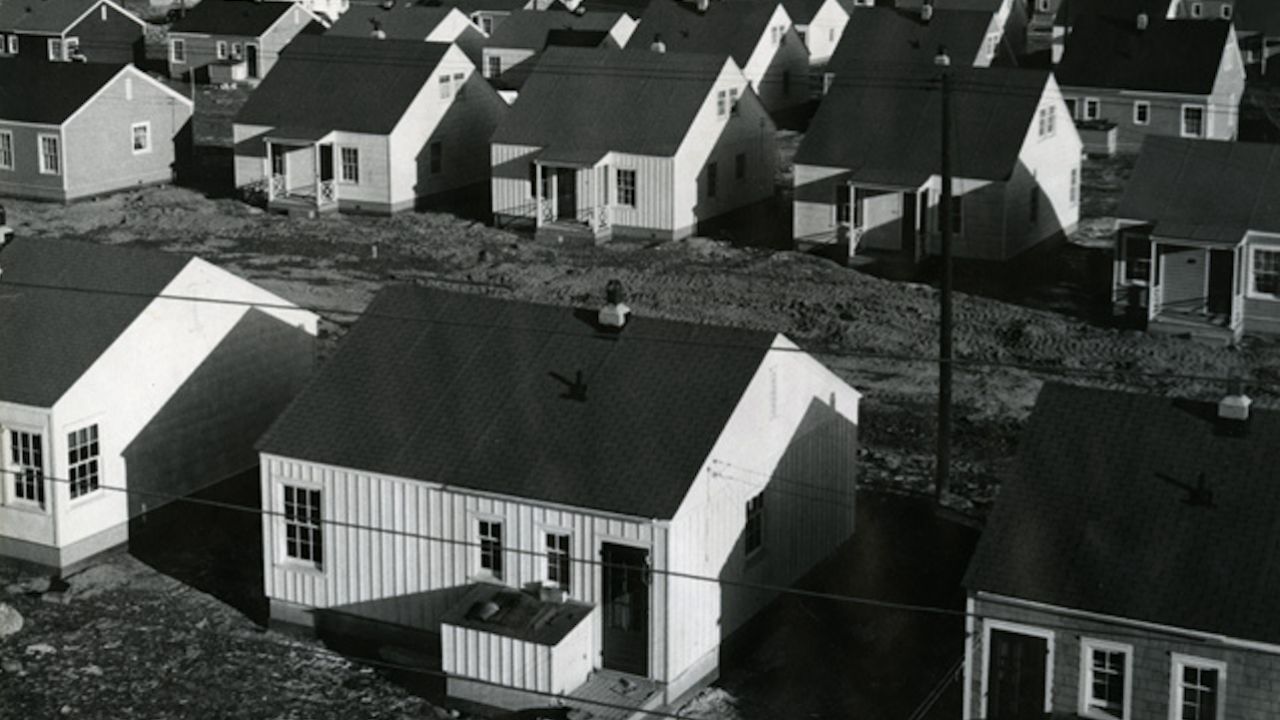
Wartime Housing Limited project in Hamilton. (Hamilton Spectator/Courtesy of the Hamilton Public Library)
OMSSA Past Presidents:
- Frances Flanigan (1970-71)
- D.R. MacLeod (1971-72)
- Murray Smith (1972-73)
- W.D. Bidger (1973-74)
- Maurice Fraser (1974-75)
- Paul Schaak (1975-76)
- Jack Nolan (1976-77)
- Rene Howard (1977-78)
- Gerry Turner (1978-79)
- John Fleming (1979-80)
Key Facts and Info About the 1970s
- Population of Canada in 1970: 21,297,000
- Population of Ontario in 1970: 7,463,058
- Prime Minister in 1970: Pierre Trudeau
- Premier in 1970: John Robarts
Key Events:
- TVOntario begins broadcasting.
- October Crisis: Pierre Trudeau introduces the War Measures Act to deal with the FLQ threat.
- Ontario Place opens in Toronto.
- The Royal Canadian Mounted Police celebrate their 100th anniversary.
- Dorothea Crittenden of Ontario becomes Canada’s first female deputy minister with the Ministry of Community & Social Services.
- The CN Tower is completed in Toronto.
- The Toronto Blue Jays play their first Major League Baseball game at Exhibition Stadium in Toronto.
1970’s
OMSSA expanded its focus to include training and capacity-building for municipal social service administrators. It became a hub for professional development and knowledge-sharing.
Key Milestones and Accomplishments During the 1970s
- The Report of the Committee on Government Productivity (COGP) is released. The Department of Social and Family Services is renamed to Ministry of Community and Social Services (MCSS).
- The Federal Government's Health and Welfare Orange Paper is released.
- Guaranteed Annual Income System (GAINS) for the Disabled.
- Homes for Retarded persons ‘Apartment Program.’
- Guide Dogs, WheelTrans, public washrooms retrofitted.
- Ontario Treasurer (now known as Finance Minister), Darcy McKeough, introduces austerity package where all government benefits are de-indexed.
- No increases in social assistance despite high inflation.
- Children’s Services Division formed.
- MCSS began process of decentralization in 1978.
- No increases in social assistance despite high inflation.
- Employables separated from Unemployables under Family Benefits.
- MCSS created Area and Regional Offices.
- Areas divided into adults and children in support of decentralization.
- First federal benefits become available through the tax system.
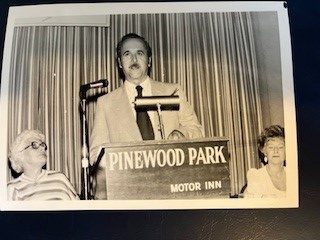
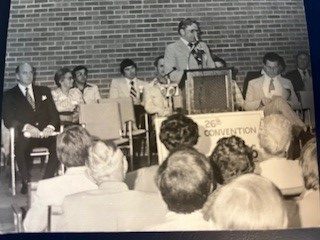
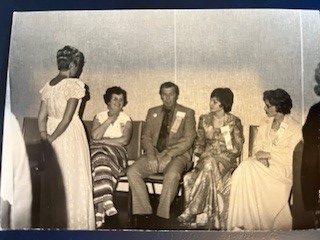
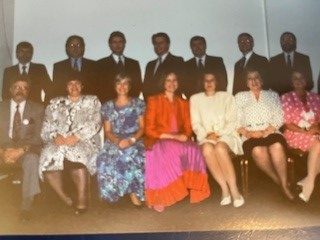









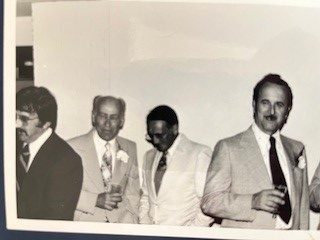
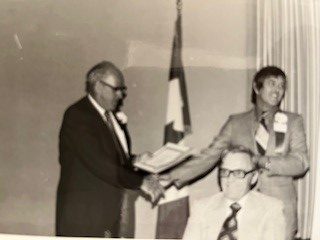
Coming of Age in a Man’s World – The Life, Times and Wisdom of Dorothea Crittenden, Canada’s First Female Deputy Minister
“In the face of ballooning social assistance caseloads, several Ontario ministries, led by the Ministry of Community and Social Services, collaborated to tackle the issues relating to rising poverty and social need. Part of the work involved ministry staff looking to the past to identify any parallels between the economic situation of the 1990s and that of the 1930s.
And that led them to Dr. Dorothea Crittenden. As Deputy Minister of Community and Social Services from 1974 – 1978 (in fact, Dr. Crittenden was the first female deputy minister in Canada), her remarkable career with the Ontario civil service began in 1937 at the height of the Great Depression. As a statistician, the figures she compiled summarized the grim social conditions of the time. In 1937, 320,000 Ontarians — one out of 10 — were on welfare.
During the post-war boom, which saw the dramatic expansion of Ontario’s social programs, Dr. Crittenden worked hard and rose to positions of increasing responsibility, including Ontario’s chief negotiator in the deliberations that resulted in the creation of the Canada Assistance Plan.”
The life, times and wisdom of Dorothea Crittenden Canada’s first female deputy minister by Mary Ann Murphy, John Stapleton and Catherine Laframboise
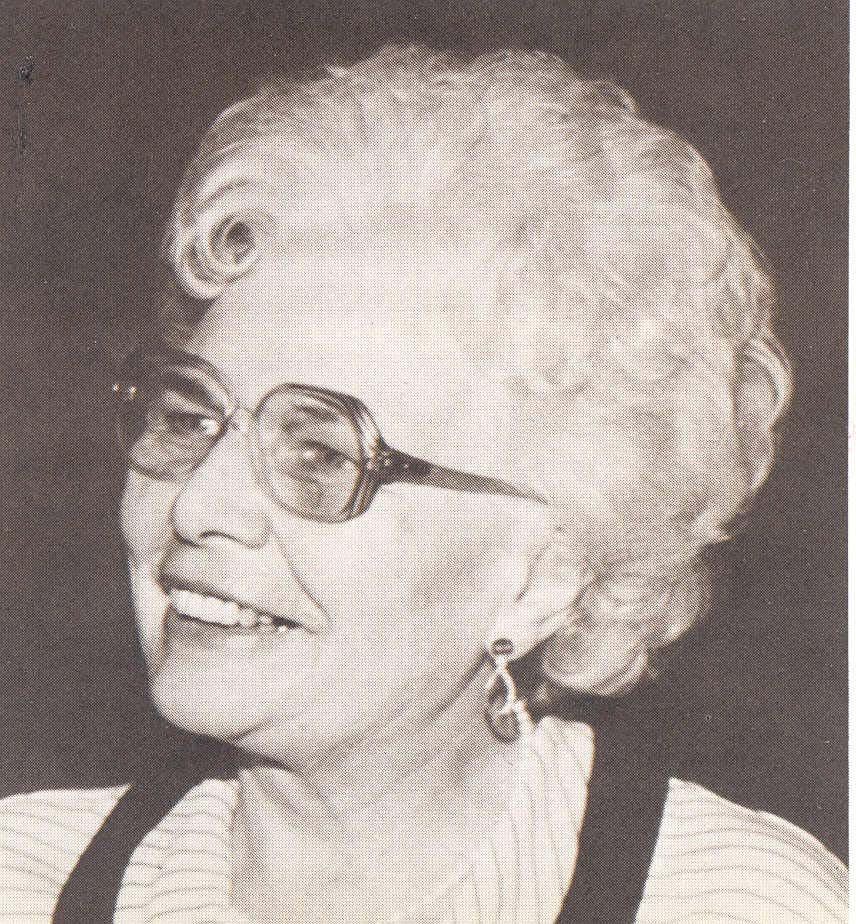
Dr. Dorothea Crittenden. (Photo courtesy of John Stapleton)
OMSSA Past Presidents:
- John Fleming (1980-81)
- W. McMillin Carson (1981-82)
- Ray Tomlinson (1982-83)
- Arthur Pope (1983-84)
- Phil Johnston (1984-85)
- Alan P. Wells (1985-86)
- Catherine Francis (1986-87)
- Garry Cubitt (1987-88)
- Ray Lazanik (1988-89)
- Dick Stewart (1989-90)
Key Facts and Info About the 1980s
- Population of Canada in 1980: 24,517,000
- Population of Ontario in 1980: 8,746,013
- Prime Minister in 1980: Joe Clark/Pierre Trudeau
- Premier in 1980: Bill Davis
Key Events:
- “O Canada” becomes the official national anthem.
- Terry Fox begins his Marathon of Hope run across Canada in support of cancer research.
- First reported cases of AIDS in Canada.
- The Constitution Act, 1982, including the Charter of Rights and Freedoms, comes into effect.
- Marc Garneau becomes the first Canadian in space.
- Rick Hansen launches his Man in Motion world tour to raise money for spinal cord research.
- Lincoln Alexander becomes the Lieutenant-Governor of Ontario, the first Black person to hold a vice-regal position in Canada.
- The Canadian-American Free Trade Agreement comes into effect.
- The SkyDome is opened in Toronto.
- École Polytechnique massacre occurs with the murder of 14 women.
1980’s
TBD
Key Milestones and Accomplishments During the 1980s
- Social Assistance ‘integration' announced which included seven ‘test sites’ to explore how different service delivery models could improve outcomes for clients.
- Changes to supports occur: "potentially unemployable," and disabled persons consolidated, supports now include those aged 60-64 who are widows, or spouse of disabled.
- Ontario introduces the Special Services at Home Program, including Supported Independent Living and Family Home Programs, to support children and adults with developmental disabilities to live at home with their families.
- MCSS Areas consolidated under one Area Manager and ‘Operations Management’ begins.
- Minister Sweeney announces the Social Assistance Review Committee (SARC).
- Ontario launched a 25-year plan to deinstitutionalize its mental health system with a focus on shifting to community-based care.
- SARC Transitions report published creating a new vision for social assistance and related programs that called for a radically redesigned set of child benefits, a new income program for persons with disabilities and a new direction to bring welfare recipients into the mainstream of community life.
- Restructuring of social assistance through the Supports to Employment Program (STEP) program, shifting focus from traditional welfare programs to promoting self-sufficiency and employment.
- Under NDP: Back on Track calls for implementation of Transitions.
- Long-Term Care transferred to Ministry of Health.



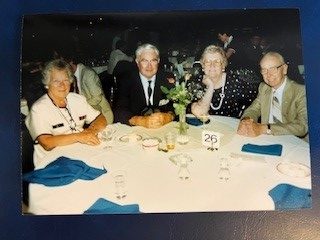
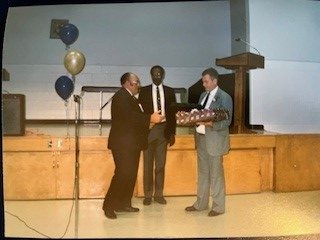
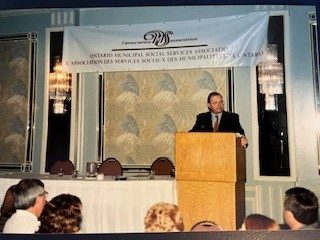
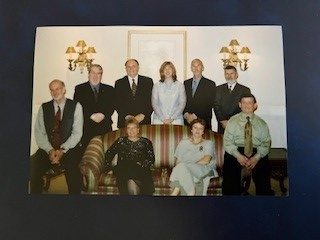


Social Assistance Review Commission’s Transitions Report
“The Ontario public of 1988 saw participation in the labour force as the answer to economic insecurity for all adults. The prevailing view was that poverty was an individual deficit, as opposed to a set of societal or labour market faults….The public was calling on government to redesign social assistance so that it would give people outside of the mainstream the tools to achieve economic self-sufficiency.
As a response, Transitions developed a vision of an entirely redesigned welfare system, in order to make it the “residual program that it was always intended to be.”
To this end, Transitions recommended that both children and people with disabilities be ‘taken out’ of the welfare system. Like seniors a generation earlier, the idea was to provide for children and people with disabilities through other income security programs and measures, ensuring that they would not have to resort to social assistance if they were without alternative resources.
Welfare would become a smaller program for adults only and would resemble a labour market adjustment program much more than a needs-based program meant to support families that had fallen on hard times.”
Transitions Revisited: Implementing the Vision by John Stapleton, Caledon Institute of Social Policy, September 2004
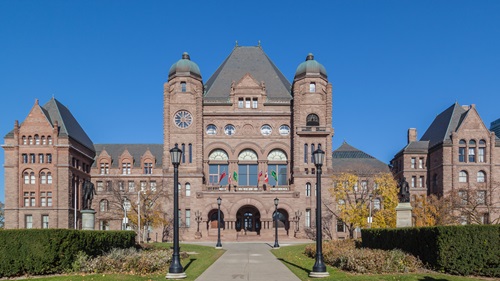
Queen’s Park
CANADA – SEPTEMBER 06: Bob Rae 1990 (Photo by Boris Spremo/Toronto Star via Getty Images)
Photo of Mike Harris by Frank Gunn/Toronto Star
OMSSA Past Presidents:
- Marna Ramsden (1990-91)
- David Court (1991-92)
- Harold Duff (1992-93)
- Joann Simmons (1993-94)
- Ian Turnbull (1994-95)
- Heather MacVicar (1995-96)
- Beth Blowes (1996-97)
- Alfred Spencer (1997-98)
- Merv Sabey (1998-99)
- Kim Warner (1999-00)
Key Facts and Info About the 1990s
- Population of Canada in 1990: 29,697,530
- Population of Ontario in 1990: 10,295,832
- Prime Minister in 1990: Brian Mulroney
- Premier in 1990: David Peterson/Bob Rae
Key Events:
- Dr. Roberta Bondar becomes the first Canadian woman in space.
- North American Free Trade Agreement (NAFTA) goes into effect.
- The 1995 Quebec referendum is held on sovereignty. The No side narrowly wins.
- Mr. Dressup does his last show.
- The last federally run Indian residential school (the Gordon Residential School), closed in Punnichy, Saskatchewan.
- Toronto and six other communities are merged to form a new megacity.
- The Supreme Court expands gay spousal rights.
- Julie Payette becomes the first Canadian to board the International Space Station.
- Quebec introduces the Educational Childcare Act, a low-fee childcare system.
1990’s
OMSSA became a critical advocate for municipalities, emphasizing the need for sufficient funding and clear guidelines for service delivery. It helped municipalities navigate the complexities of assuming greater responsibility for housing, social assistance, and childcare services.
The 1990s can be summarized as a tale of two halves, economically and politically. The impact of this period is still felt today, 25 years after the decade ended.
Economic contraction and high unemployment rates kicked off the 1990s in Ontario and Canada. At both levels, governments were struggling with growing debt, deficits, growing numbers on social assistance, and strategies to bring public finances in order.
Politically, the early 1990s were a period of great realignment as Indigenous relations moved to the national forefront through the Oka Crisis and the battle over land rights. This period also included ambitious federal constitutional frameworks and amendments that were coming to a close through the defeat of the Meech Lake and Charlottetown Accords. The fall out from this ambition saw the revival of Quebec separatism and its culmination with a narrow defeat in 1995 Quebec Referendum.
On September 6, 1990, Ontario found itself with its first-ever NDP government led by Bob Rae. Across the province, finances were tightening due to the recession, and the government was forced to employ austerity measures like the “Social Contract” that kept many people employed but mandated unpaid days off for public service workers to reduce the deficit and keep a record-high 12% unemployment rate from growing. At the same time, his government, realizing many were suffering, increased social assistance benefits to those who needed them.
In 1994, the Federal Government began the first of several budgets designed to reign in the federal deficit, by slashing spending to cut the deficit. Unemployment Insurance and provincial transfer payments are hit hard and cut back severely.
While the second half of the decade was equally tulmultuous, the economic issues earlier in the decade faded away as Ontario and Canada benefitted from major economic expansion and boom from the United States.
The federal budget was balanced by the downloading programs and services to the provinces, or the outright cancellation of these programs to save money. The provinces, in turn, downloaded services to municipalities in an effort to balance their budgets and get out of providing unpopular programs and services.
For example, the new provincial government enacted an unprecedented 21.6 per cent cut to social assistance rates. In 1996, the Canada Assistance Plan (CAP), the federal-provincial cost sharing mechanism for a social assistance was terminated, significantly reducing the amount of federal contributions to these programs.
In Ontario, the second half of the decade began on June 8, 1995, as the Ontario PC Party was elected on their “Common Sense Revolution” that focused on individual economic responsibility, welfare reforms, smaller government, reducing taxes, and the reform of government operations and services.
As noted in The Harris Legacy: Reflections on a Transformational Premier:
“They understood the depth of unhappiness and worry among the public after five years of Rae’s NDP government and a major recession…They understood that people really wanted to change. The winner would be the party that was most convincing that it would bring change. To that fight the Liberals brought a Swiss army knife while Mike Harris brought a bazooka.”
Over the course of their two terms in power made systemic changes to reduce the size of government and lower taxes. Along the way, battles were fought with many unions and municipalities…….
Key Milestones and Accomplishments During the 1990s
- Recession hits Ontario very hard.
- Cap on Canada Assistance Program.
- Ontario Expenditure Control Program
- Federal Employment Insurance cuts - focusing on cutting deficit
- Child care promised but not implemented
- Regions consolidated into Areas??
- Ontario Case file Investigation
- Social Assistance caseloads hit all time peak – 12% of population
- Rates Reduced, OW introduced, rule changes, workfare.
- Canada Assistance Program cancelled.
- Major overhaul of MCSS' automated system for social assistance announced and implementation of Social Delivery Model Technology begins.
- OW and ODSP introduced creating a separate legislative mandate (again) for adults with disabilities.
- National Child Benefit introduced


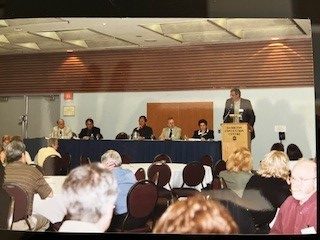
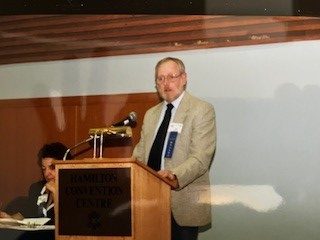


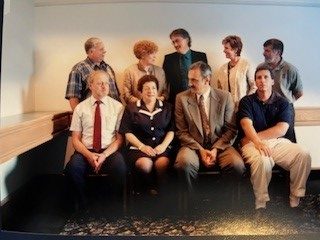







Ontario Works
“The Ontario government undertook significant welfare reforms in the late 1990s. These reforms separated those in need of social assistance into two categories—people unemployed but considered employable, and people with disabilities (Community Development Halton, 1998). Ontario Works became the program intended to support those in need but considered employable. As articulated in the preamble of the Ontario Works Act, 1997, the program is “intended to provide temporary financial assistance to those most in need while they satisfy obligations to become and stay employed.” In addition to emphasizing the individual’s responsibility and promoting “self reliance through employment,” the Act also sets out to “effectively serve” the people needing assistance (Government of Ontario, 1997).
The underlying philosophy of the program is that poverty and income insecurity are likely to be short-lived, and that a strong economy buoyed with employment opportunities should be able to reabsorb people into the labour market, particularly those who “satisfy their obligations to become and stay employed” (Government of Ontario, 1997), therefore making poverty a temporary experience.
System transformation in Ontario Works by Garmina Talwar Kapoor, Maytree, January 2020

Queen’s Park
OMSSA Past Presidents:
- K.J. (Ken) Dick (2000-01)
- Jo-Anne Paluzzi (2001-02)
- Michael Schuster (2002-03)
- Adelina Urbanski (2003-04)
- Danielle Masse (2004-05)
- Richard Williams (2005-07)
- Brian Hutchings (2007-08)
- Brenda Patterson (2008-09)
- Patti Moore (2009-10)
Key Facts and Info About the 2000s
- Population of Canada in 2000: 30,685,730
- Population of Ontario in 2000: 11,669,300
- Prime Minister in 2000: Jean Chretien
- Premier in 2000: Mike Harris
Key Events:
- E. coli outbreak in Walkerton, Ontario.
- Canada introduces the Civil Marriage Act, making Canada the fourth country to sanction same-sex marriage.
- The Ontario cities of Ottawa, Hamilton and Sudbury have their surrounding suburbs merged into their municipalities.
- September 11 attacks occur in New York City, Washington, and Pennsylvania.
- Ontario declares a public health emergency as a result of SARS. Molson Canadian Rocks for Toronto, also known as SARSStock, was a benefit rock concert that was held on July 30, 2003.
- A massive blackout hits Ontario and the northeastern United States.
2000’s
OMSSA has increasingly focused on providing training, certification, and professional development opportunities for municipal staff involved in housing, social assistance, childcare, and other social services.
OMSSA actively engages in consultations with the provincial government, ensuring that municipal voices are heard in policy changes affecting social services and advocates for:
- Adequate provincial funding for municipal social services.
- Fair and effective policies related to homelessness, affordable housing, and childcare.
- Coordination between municipal, provincial, and federal levels of government.
Key Milestones and Accomplishments During the 2000s
- The Ontario College of Social Workers and Social Service Workers (the College) is the regulatory body for social workers and social service workers in Ontario. The College was created when the province of Ontario fully proclaimed the Social Work and Social Service Work Act, 1998 on August 15, 2000.
- Employment Supports become an integral part of ODSP income and services.
- Federal Government’s new National Homelessness Initiative started to provide funding for the Supporting Community Partnerships Initiative (SCPI), which was targeted at transitional housing for the homeless. This funding was being administered by select municipalities.
- Province devolves funding and administration of existing social housing to OMSSA Members.
- Ministry of Community and Social Services (MCSS) renamed to Ministry of Community, Family and Children's Services (MCFCS).
- Federal Government returned to the funding of housing development programs and announced $680 million for an Affordable Housing Program (AHP) to be administered by provinces which provide matching funding.
- MCFCS split into Ministry of Community and Social Services (MCSS) and Ministry of Children and Youth Services (MCYS).
- Programs for children placed within new MCYS.
The Accessibility for Ontarians with Disabilities Act (AODA)
“In 2005, the AODA passed into law with unanimous support from all three political parties. This landmark legislation started Ontario on a journey to create an accessible province within 20 years. [The province] knew that changing the focus from disability to ability was necessary for our future prosperity, but would present a formidable challenge — one that would require a culture change.
Embracing the business case for accessibility is a win-win proposition for organizations of all sizes and for people with disabilities. The bottom line is that an accessible province means more opportunities for all Ontarians.
For Ontario’s 1.8 million people with disabilities, it means being able to actively participate in our communities, workforce and economy.
For business, it means tapping into an underused talent pool, creating new products and services based on universal design, and harnessing the buying power of more people, both in-store and online.
For our economy, it means up to a $600 a year per capita increase in the gross domestic product.
That makes becoming accessible and promoting accessibility not just the right thing to do, but also the smart thing to do for businesses and organizations of all sizes.”
The Path to 2025: Ontario’s Accessibility Action Plan (Government of Ontario, 2005)

OMSSA Past Presidents:
- David Rennie (2010-11)
- Douglas Bartholomew-Saunders (2011-12)
- David Landers (2012-13)
- Janet Menard (2013-14)
- Catherine Matheson (2014-2015)
- Keith Palmer (2015-17)
- Elaine Baxter Trahair (2017-19)
- Dan McCormick (2019-21)
- Cathy Cousins (2021-23)
- Henry Wall (2023-25)
Key Facts and Info About the 2010s and 2020s
2010s
- Population of Canada in 2010: 34,019,000
- Population of Ontario in 2010: 13,167,900
- Prime Minister in 2010: Stephen Harper
- Premier in 2010: Dalton McGuinty
2020s
- Population of Canada in 2020: 38,005,238
- Population of Ontario in 2020: 15,996,989
- Prime Minister in 2020: Justin Trudeau
- Premier in 2020: Doug Ford
Key Events:
- A state funeral is held for Jack Layton.
- The Royal Canadian Mint discontinues distribution of the penny.
- Kathleen Wynne is sworn in as premier of Ontario becoming Ontario’s first female premier and Canada’s first openly gay premier.
- Chris Hadfield became the first Canadian to be the commander of the International Space Station (ISS).
- 50th anniversary of the National Flag of Canada.
- The Tragically Hip’s final concert is held in Kingston, Ontario, and broadcast nationwide.
- Canada celebrates its 150 anniversary.
- The Toronto Raptors win their first NBA championship.
- Canada closes its border with the United States to non-essential travel due to the COVID-19 pandemic.
- In 2021, a new national holiday, National Day for Truth and Reconciliation, is created and held to remember lives lost at residential schools.
- The Federal Government invokes the Emergencies Act for the first time in response to the protests and blockades known as the “Freedom Convoy.”
- King Charles III becomes the King of Canada after the death of Queen Elizabeth II.
2010’s
This period covers the last fifteen years, right up to the present day, after OMSSA’s 60th Anniversary in 2010.
OMSSA acts as a human services integration catalyst by linking stakeholders across sectors and issues and providing leadership in human services planning. At the same time, it develops strategic partnerships with like-minded organizations to strengthen advocacy on the key policy issues of the day.
OMSSA also managed and delivered Supportive Approaches through Innovative Learning (SAIL) front-line training in many communities across the province. The Association enhances its professional development and Conferences for knowledge exchange and Member value and benefit.
Key Milestones and Accomplishments During the 2010s
- OMSSA celebrates its 60th Anniversary.
- The Province’s Long Term Affordable Housing Strategy confirmed the devolution of social housing to municipalities and required community-based local planning of housing and homelessness services including social housing in Ontario.
- The Ontario Government appoint Frances Lankin and Munir A. Sheikh to lead a comprehensive review of social assistance in Ontario.
- The Housing Services Act, 2011 sets basic Provincial policy directions while
giving service managers greater flexibility and control in the planning and delivery of housing and homelessness services including social housing administration.
- The Brighter Prospects: Transforming Social Assistance in Ontario report, written by Frances Lankin and Munir A. Sheikh, is published outlining 108 recommendations to enhance social assistance in Ontario.
Key Milestones and Accomplishments During the 2020s
- The Provincial Government declares an emergency as a result of the spread of the COVID-19 disease. Public spaces were closed and events were cancelled as a result. Long-term care facilities were some of the hardest hit spaces in the Province as many elderly residents fell ill and died as a result.
- OMSSA and the Province establish the Provincial-Municipal Human Services Collaborative (PMHSC) Table to share information, provide input, and advocate directly to the province to receive buy-in through the rapid pace of policy changes coming from Queen’s Park
- The Governments of Ontario and Canada sign an agreement for the Canada-wide early learning and child care program (CWELCC).
- The Russian invasion of Ukraine begins. OMSSA Members assist the Federal Government with resettlement efforts through the Canada Ukrainian Authorization for Emergency Travel (CUAET) program.
- OMSSA, NOSDA, and AMO, release a report quantifying current and projected homelessness, identify and cost provincial-level solutions to achieve functional zero by 2030, and determine the investment gap between current and required funding across all government levels.
The Canada-Wide Early Learning and Child Care Program (CWELCC)
“In 2020, Canada embarked on a new approach to early learning and child care. The COVID-19 pandemic’s impact on women’s employment, families and capacity of child care services to maintain operations stimulated widespread recognition that reliable, affordable, high quality child care is essential not only for families, children and women’s equality but also for Canada’s economy and future prosperity. The idea that universal access to quality child care is central to our recovery from the pandemic became a key driver for building a Canada-wide early learning and child care system for all.”
Canada-wide early learninig and child care agreements (childcarecanada.org, May 25, 2022)

Resources
Here is a brief (but growing) list of resources used to help develop this page and help archive the history of social services in Ontario.
Website Links
- Transitions Revisited: Implementing the Vision by John Stapleton (September 7, 2004)
- Closing Institutions For People With A Developmental Disability (Government of Ontario, March 31, 2009)
- Ontario Enacts Declaration of Emergency to Protect the Public (Government of Ontario, March 17, 2020)
- $13.2 Billion Child Care Deal will Lower Fees for Families (Government of Ontario, March 28, 2022)
- Canada-wide early learning and child care agreements (childcarecanada.org, May 25, 2022)
- Home front: Why housing became part of Canada’s war effort by Karen Black (March 6, 2024)
- ‘Good Citizens Dwell Here’: The story behind Canada’s oldest social-housing project by Jamie Bradburn (April 12, 2024)
- How Good Was Mike Harris? by Ian Urquhart, The Dorchester Review (July 18, 2024)
- The rise and fall of co-op housing in Ontario by Kunal Chaudhary (November 4, 2024)
- Common Sense Revolution (wikipedia)
- Ontario Child Benefit (Government of Ontario)
- Public Housing in Canada (wikipedia)
Presentations
- Social Services in Ontario: The historical context, changing themes, movements and innovations over two centuries by John Stapleton (March 1, 2006)
- OMSSA 60th Anniversary: The historical lead up by John Stapleton (June 8, 2010)
- A History of First Nations Social Services Arrangements Within MCCSS and its Predecessors by John Stapleton (November 15, 2023)
- OMSSA 75th Anniversary: from 1950 to 2025 by John Stapleton (May 13, 2025)
Reports and Publications
- Report of the Lieutenant-Governor’s Committee on Housing Conditions in Toronto (1934)
- Hamilton Demonstration Project by the Government of Ontario, November 1964.
- Workfare: A Poor Law by Sherri Torjman (February 1996)
- System transformation in Ontario Works by Garima Talwar Kapoor (January 2020)
- Coming of Age in a Man’s World: The Life, Times and Wisdom of Dorothea Crittenden by John Stapleton and Catherine Laframboise (January 2007)
- Brighter Prospects: Transforming Social Assistance in Ontario by Francis Lankin and Munir A. Sheikh, 2012.
- Archived – The Path to 2025: Ontario’s Accessibility Action Plan by the Government of Ontario, 2015.
- Finding Usual Suspects: Why higher social assistance rates don’t always lead to higher caseloads by John Stapleton and Yvonne Yuan (March 2021)
- Municipalities Under Pressure: The Human and Financial Cost of Ontario’s Homelessness Crisis by Donaldson, J., Wang, D., Escamilla, C., & Turner, A. (2025).
- Timeline: A History of Social Housing in Ontario by the Ontario Non-Profit Housing Association (ONPHA)
- Municipal Social Services in Ontario: 1935-1940 by John Stapleton
- The Campbell Report: The Origins of Modern Public Assistance in Ontario by John Stapleton and Catherine Laframboise
Legislation
- Ontario (1960) “c 87 Day Nurseries Act,” Ontario: Revised Statutes: Vol. 1960: Iss. 1, Article 90.
- Ontario (1980) “c 131 Elderly Persons Centres Act,” Ontario: Revised Statutes: Vol. 1980: Iss. 2, Article 40.
- Ontario (1960) “c 53 Child Welfare Act,” Ontario: Revised Statutes: Vol. 1960: Iss. 1, Article 56.
- Homemakers and Nurses Services Act , RSO 1960, c 173
- Social Work and Social Service Work Act, 1998, S.O. 1998, c. 31
- Accessibility for Ontarians with Disabilities Act, 2005, S.O. 2005, c. 11
